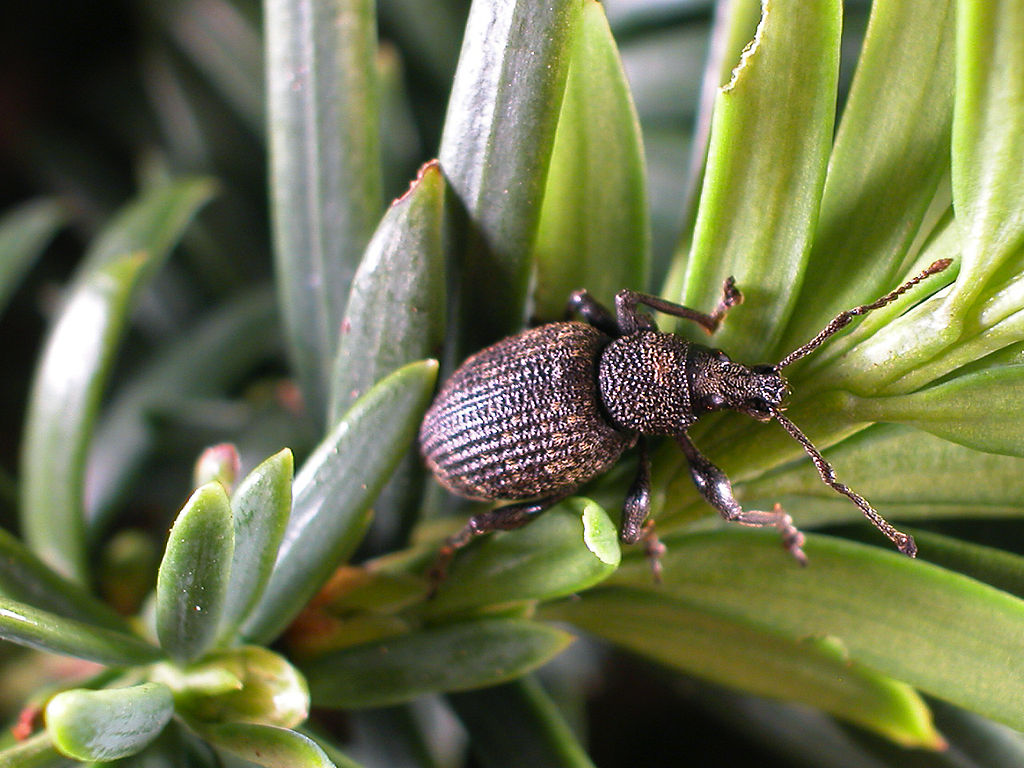Introduction
Black vine weevil (Otiorhynchus sulcatus), also referred to as vine weevil or taxus weevil, is a serious pest of ornamental plantings. The insect is native to Europe. It was first reported in the United States in 1910. Black vine weevil is most destructive in its larval stage, when it feeds on the root systems of host plants.
Distribution & Habitat
Black vine weevil is prevalent across the northern United States, Canada, and Europe.
Hosts
Black vine weevil has been reported to infest more than one hundred species of plants. The insect prefers bergenis, euonymus, Japanese holly, rhododendron, and yew. In addition to these hosts, the larvae feed on the roots of hemlock, as well as various weeds, such as cocklebur, Joe-pye weed, morning glory, ragweed, and thistle. Other plants prone to infestation include asters, azalea, begonia, cyclamens, forsythia, fuchsia, hemlock, impatiens, primrose, and sedum. The insect commonly infests blueberry, blackberry, cranberry, and strawberry plants.
Description
The larvae are creamy-white in color, with a tan to brown head. They have a slightly curved, legless body that grows up to ¾ of an inch long. Adults are gray to black, and have a short, broad snout, from which bent antennae arise. Adults have wings, but cannot fly. The front wings are laden with small patches of short golden hairs.
Life Cycle
Black vine weevil produces one generation per year. Immature larvae overwinter in the soil beneath host plants. They become active in spring, briefly feeding until they are fully mature. Mature larvae measure ¼ to ¾ of an inch long. Once mature, the larvae form pupal cells in the soil, and commence pupation. Pupation occurs in the upper soil layers. Adults emerge from the pupal cells from late May to July. They are nocturnal, feeding on host plants during the evening. The adults gnaw u-shaped notches in the leaf margins. When disturbed, the adults vacate the host plant, and plummet to the ground, concealing themselves in leaf litter, and mulch. During the day, they navigate to the stems of plants with dense foliage, or to debris beneath the host plant. They reside in these locations until night falls, whereupon they resume feeding. While black vine weevil is capable of producing male adults, only females have been observed. Females have the ability to reproduce parthenogenetically. They require 21 to 28 days of feeding before they can lay eggs. Once the adults have consumed sufficient foliage, they lay up to 500 eggs in the soil near the base of host plants. The females lay their eggs throughout July and August. The eggs hatch in 10 to 14 days, revealing masses of larvae. The larvae feed on plant and grass roots until temperatures become consistently cool in fall. Once the temperatures drop below 50°F, the larvae burrow deeper into the soil, where they overwinter. The larvae may generally be found at a depth of ¾ of an inch to 16 inches in the soil around the plant’s roots.
Symptoms of Infestation
The larvae feed on the roots of host plants. They initially feed on small tender roots, before progressing to the bark of large roots, or the stem. This generally results in the destruction of the plant’s root system. Infested plants in landscape settings often succumb to the widespread root destruction. The adults feed on the outer edges of the plant’s leaves, causing the leaves to develop notched margins. Evergreen plants, such as rhododendron, euonymus, and bergenis are particularly susceptible to this type of injury. Marginal notching of the foliage seldom impacts plant health. Significant notching of the leaves can reduce the ornamental value of the host.
Management
- Various insecticides are registered for use on black vine weevil. Applications should be performed on plant foliage from mid-May to early June, with two subsequent applications made at fourteen day intervals. For the best results, spray plant foliage in the early evening, when the adults become active, and resume their feeding activities.
- Soil insecticides are effective at controlling the larvae. Insecticides can be administered from July to October.
- For plants that are grown in gardens or containers, beneficial nematodes can assist in managing the larvae. To ensure success, release nematodes into gardens and containers in early June. Apply water to the soil as directed by the product label.
- Sticky barriers may be used to deter the adults from ascending the trunks of host plants. Avoid placing the sticky material directly on the bark.
- The adults can be manually removed from the foliage at night. Gently shake the plants to dislodge the insects. If desired, the adults may be submerged in soapy water thereafter.
- Remove dead or infested foliage to limit overwintering sites. Discard infested plant material, including the soil around the root system.
- Eradicate weeds from lawns and gardens to remove potential food sources.
- Black vine weevil has several natural predators that help to limit its populations. These include bluebirds, warblers, and wrens.
Photo courtesy of United States Department of Agriculture.


